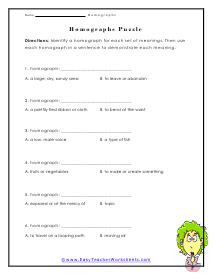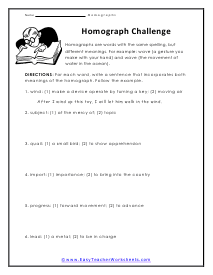It's all about context. Homographs are one of those things that make you unhappy with the English language as a whole. When you come across two words that have different meanings, but are spelled the same; they are called homographs. Put yourself in the shoes of a person learning this language of ours and coming across a sentence like. "The lawyer did not object to his client holding the object that was used to commit the crime." I mean come on people, that's just annoying.
The following collection of activity sheets will teach your students how to spot and interpret homographs, those words that are spelled the same, but which are pronounced differently and have different definitions. Students will be asked to define highlighted words using sentence context clues, choose the correct definition for a selected word based on its use in a sentence, and more. Extra project idea: Have your students construct a Venn diagram with homographs on one side, homophones on the other, and homonyms in the middle.
Print Homograph Worksheets
Click the buttons to print each worksheet and associated answer key.

Underlined Sentences
Write the meaning of each underlined word. Homographs can also sometimes be pronounced differently.


Word Bubbles
Read the definitions. Choose the correct word from the Word Box to go with each set of definitions.

Using Context Clues
For example: bat (a piece of wood used to hit a ball) and bat (a flying, nocturnal rodent). Read each sentence. Choose the correct meaning for each word that you are presented with.

More Use of the Context Clues
In the following sentences, underline the homograph that matches the meaning provided in italics after the sentences.

Homographs Puzzle
Identify a word for each set of meanings. Then use each word with the same meaning in a sentence to demonstrate each meaning.


Underlining Sentences
The underlined word in each sentence is a homograph. On the first line, write the meaning of the underlined word as it is used in the sentence. On the second line, write one of the word's other meanings.

Name That Word
Now use the words that you identified to complete each sentence. On the line, indicate which meaning applies.





Pairs of Words
For each homograph write two sentences, one that demonstrates each meaning of the word.

Homograph Challenge
For each word, write a sentence that incorporates both meanings it. Follow the example.
What are Homographs? Why Do We Use Them?
The bears have to bear the brunt of global warming.
In the sentence above, you will notice that bear appears twice but has a different meaning. The words that are exact replicas of each other but have different meanings are known as homographs. They even have the same sound.
Homographs usually confuse readers because the meaning of such words depends on the context around which they are used. Content is a feeling also and a term used for things that are contained inside something. He is content with the content of his job.
If a word has a slightly different pronunciation but has the exact spellings with different meanings, it is called a homophone. While a homograph has the same pronunciation, making it difficult for readers or listeners to distinguish. The word desert can be an example of a homophone. It has two meanings: to leave someone behind deliberately, and the other is the type of an ecosystem (barren land). The first is pronounced as "Dih-zhurt," while the latter is pronounced as "Deh-zhurt."
Examples of Homographs
Here are some examples of homographs with sentences to elaborate on the importance and understanding of such words.
1. Bat: An animal / A piece of equipment used in sports
The bat can fly with swiftness at night.
John always plays with his lucky bat.
She broke my favorite bat.
2. Wave: A hand gesture / A curling arched breaking on the shored
Jean dismissed the class with a wave of her hand.
At night, the pressure of sea waves becomes high.
3. Fair: Light-colored / Honest
Zoe has an extremely fair complexion.
Robert is a wise and fair lawyer.
4. Book: Reservation / A compact bundle of papers to read
We have one week's reservation in a five-star hotel.
Mike prefers to read a book when he travels.
5. Match: Similarities / Contest
She can not match the beauty of this model.
Australia vs. South Africa match will be held on Saturday night.
6. Ring: hand or finger accessories / A fighting ring.
He proposed to her with a beautiful diamond ring.
Mike challenged John to compete with him in this ring.
7. Bow: A Formal gesture to show respect or greet / A weapon for shooting arrows
Amelia bows down when she meets the queen of Britain.
The soldiers were ready with their bows to shoot arrows.
8. Skip: Jump/ Leave out
Lola skipped lunch after her boss called.
She scores high skips in skipping competitions.
9. Tear: To rip something / The liquid flow from the eyes when crying
The teacher tore apart the brawling students in the hallways and gave them detentions.
When she heard the heartbreaking news, her tears broke out.
Homographs are an essential component of the English language because it persuades a reader to dive deeper into the actual meaning of the context. It is also a prime example of "nothing that looks the same needs to be the same."
Homographs are an essential component of the English language, giving it an additional undertone to structuring sentences.



